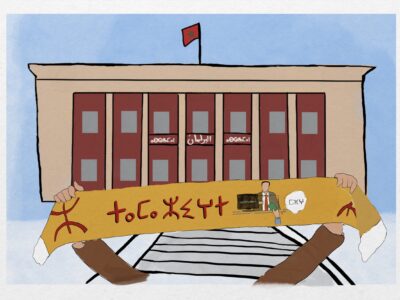With its rough terrain and harsh climate, the Great Sandy Desert in Western Australia can be a challenging place to live. For those carving out a life in this sparsely populated region, the vast distances of Australia's second largest desert can also prove to be challenging for those wanting to communicate with neighbors.
Hand signs have traditionally served as a way of communicating for the Aboriginal peoples who have been on this land for centuries, long before the arrival of mobile and digital technologies.
To recognize this practical means of communication, local producer Willi Lempert partnered with a group of enthusiastic Aboriginal women elders from the community of Balgo. Together, they created a video that told the story of 40 hand signs.
Lempert had been working in the area when the idea for an explanatory video came up. He explained the importance of these hand signs:
While many visitors quickly learn the standard “what now?” sign, it is easy to miss the dozens of diverse hand signals being subtly exchanged in conversation. As in all languages, some elements are traditional and others are recent innovations… hand signs are not only a way of communicating information, but also serve as full-bodied ways of expressing nuance, humor, and individual personality.
The video, which is part of the “Mother Tongue” project organized by ABC Open and First Languages Australia, also serves to promote the local language of Kukatja, a vulnerable language with less than 1,000 current speakers. In the video, for each hand sign that the women demonstrate there is the corresponding word in Kukatja along with its English-language translation.
Lempert wrote about how much fun he and the women had during the making of the video in a blog post.
The women elders, such as Payi Payi and Manaya who are featured in the video, play a central role in the life of the community. As members of the Kapululangu Women’s Law and Culture Centre, they are instrumental in determining the way forward for the community. The website for the centre states, “Nothing that happens at Kapululangu can happen without the Elders.”
Kapululangu’s Elders were born in the desert, and grew up and were trained in the Old Ways before the arrival of Kartiya/non-Indigenous people in their ancestral countries. This makes them custodians of an immense wealth of stories,skills and cultural knowledge. They want to share this wealth […] The Elders want their young people to grow up strong and resilient, proud of and knowledgeable in the ways of their people, secure in their peoples’ Law and Culture knowledge, so that they can better cope with the changing world. A peoples’ own Law and Culture is the glue that holds life together.
By teaming up with local producers committed to helping them tell their own story in their own language, they are ensuring that this wealth of knowledge is shared with the next generation.




4 comments
I find it hard to believe that the Aborigines have a word for Porcupine, given there aren’t any Porcupines in Australia.
So I will assume that they are referring to the Echidna (Tachyglossus aculeatus ) or Spiny Anteater.
But, apart from that, it is very interesting to learn a little more of their culture.
As an Aboriginal man we do call it a porcupine and Europeans call an Echidna!
We know what the animal is but we have just called it that
Thanks
Don
I lived in that community some years ago and I can assure you that the people DO use the word porcupine for the echidna, obviously because that’s what Kardiya called them way back. They also use other terms from early white invasion which aren’t now used by Kardiya: eg calico for tents, obviously going to back to when that’s what tents were made of.
The first two ‘what’ and ‘no/nothing’ are the same handsigns used up north in Arnhem Land, Maningrida way